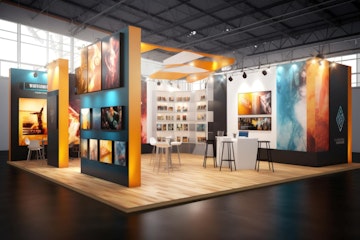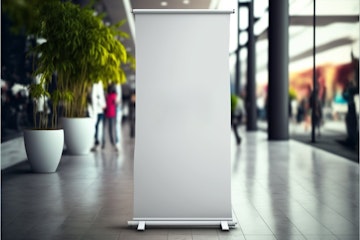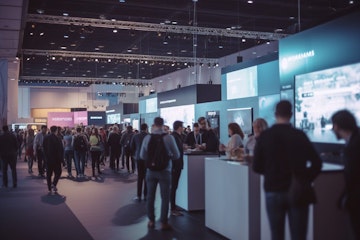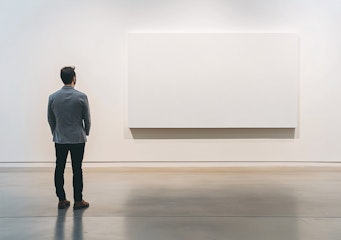Modular exhibition systems are a fantastic display solution for exhibitors who need a display stand which can fit in a number of different spaces. However, unless you are a display stand aficionado (like the team here at Display Wizard) you probably will need some tips on the best system for you.
This guide outlines the main types of modular exhibition system so you can decide which is best for you.
What is a modular exhibition system?
A modular exhibition system is made up of a number of customisable components, which can be erected and dismantled easily by the exhibitor.
A modular display stand has the advantage of simply reconfiguration without the need for a new system, making them an ideal choice for exhibitors who attend multiple shows.
Modular display systems are most widely used at trade shows, exhibitions and conferences as they can be used in a shell-scheme or for space-only stands.
They are mainly utilised for individual exhibiting spaces although many of them could be adapted to be larger backwalls for award ceremonies or other presentations.
What other names are there for a modular exhibition system?
Modular display stands
(Re)configurable display stands
Connectable display stands
Linkable display systems
Trade show modular signage
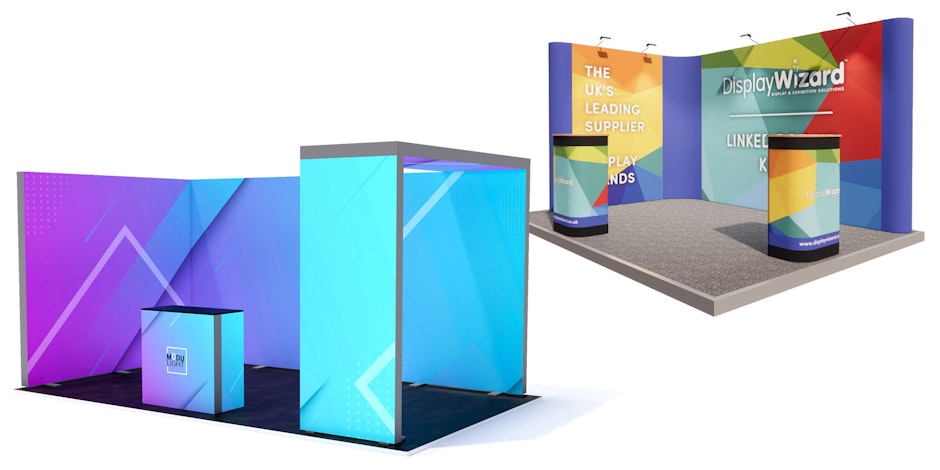
Why use a modular exhibition system?
Modular display stands are a fantastic display solution, but what makes them better than a conventional non-modular display, such as a banner stand, or a larger custom-made exhibition stand?
Cost-effective for regular exhibitors
Modular display systems are generally at the higher end of the price bracket for exhibition stands and so wouldn’t generally be cost-effective for exhibitors who perhaps only attend one or two shows per year.
However, if your company attends multiple shows throughout the year and require a different-sized stand for each of these, purchasing one modular stand and adapting it for each show could reduce your cost dramatically. They are also far cheaper than hiring or buying a large custom-made exhibition stand, which usually requires extra costs on the build and breakdown of the stand which would need to be done by an external agency or supplier.
No tools required for assembly
Unlike larger custom-made exhibition stands, modular display stands don’t require a range of specialist tools and knowledge to assemble. They are designed for assembly by the end-user and so can help you keep your whole exhibiting process in-house.
However these stands do have a number of components and as a result are more difficult to set up than conventional display stands. Therefore for most of these systems it is recommended that you read the assembly instructions carefully, watch example videos and, if possible, trial the assembly process before your event.
Easily-accessorised
Modular display stands can be configured to accommodate almost any features you require to make your stand more attractive. These can include LED TV stands, spotlights, cupboards, literature stands, shelving and much more.
The design process for a modular stand is far more collaborative than a conventional ‘off-the-shelf’ display solution as you will work with a supplier to discuss the dimensions of your ideal stand along with any different configurations you may need for different shows. This design process should also include consideration of additional components such as AV equipment and ideal lighting.
Types of Modular Stands:
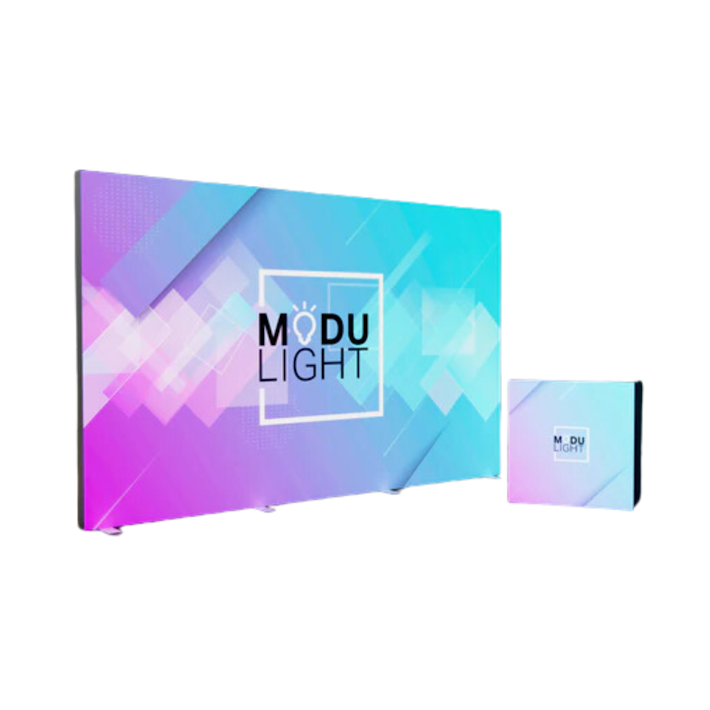
ModuLIGHT BACK-LIT EXHIBITION STANDS
ModuLIGHT is our premium solution for top tier visual displays. Built from high-quality, recyclable aluminium, These lightboxes are durable and perfect for frequent use. Built from high-quality, recyclable aluminium, they are durable and perfect for frequent use.
Each lightbox can be adjusted to multiple heights (with replacement graphics) with the option to add extension kits to increase size or remove them to decrease, giving you versatile options for various stand spaces.
Advantages
Significantly stands out against non-backlit stands
Up to 75% brighter than competitor displays, through the use of Osram LEDs
Strong & durable due to aluminium frames.
Tool-less, simple assembly.
Disadvantages
Can be expensive, when factoring in extras like counters & interactive boards.
Stand may be too busy with visitors & appreciators!
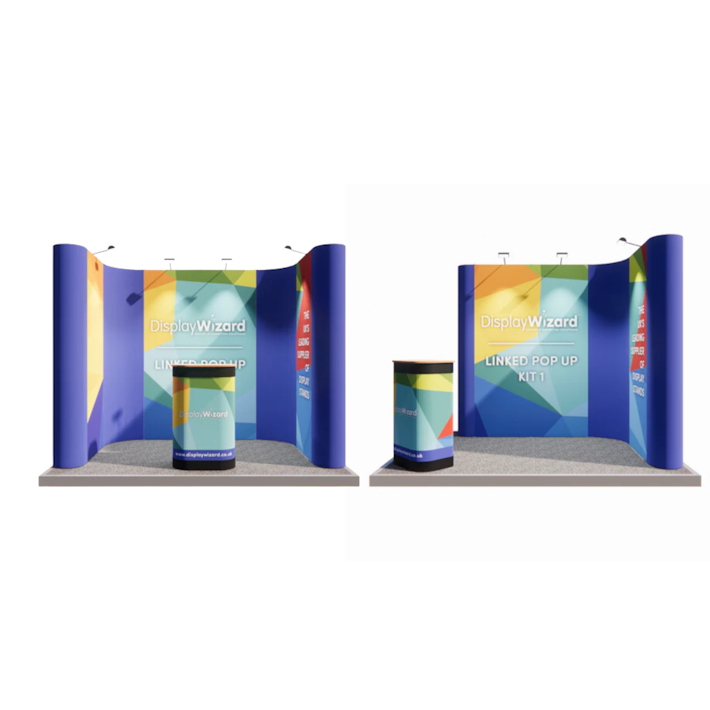
LINKED POP UP DISPLAYS
Pop up display stands are one of the most common exhibition displays, but many people don’t know they can also be linked together to form L-shaped, curved or U-shaped backwalls. Despite the expandable frame being able to fit inside a small carry case, pop up stands can still accomodate small LEDs, literature stands and shelves although the load-bearing capacity is not that high. For a more versatile load-bearing pop up a system, see the Vario D400 Pop up system.
Pop up stands are very easy to assemble without tools, the frame literally ‘pops up’ to form a large backwall on which you can attach your polypoprolene or fabric graphics using hooks and magnetic strips. Pop ups are not as versatile as some of the other systems as the individual frames cannot be attached, instead the print media bridges the gap between the individual frames.
Advantages
The easiest modular stand to assemble, no tools required
Easy to use one frame for smaller shows and add additional frames for bigger displays
One of the most cost-effective mid-scale exhibition displays
Disadvantages
Not completely modular – restricted to shape of individual frames
Light frames can’t hold very heavy accessories such as larger TVs
Doesn't have the height of other modular stands
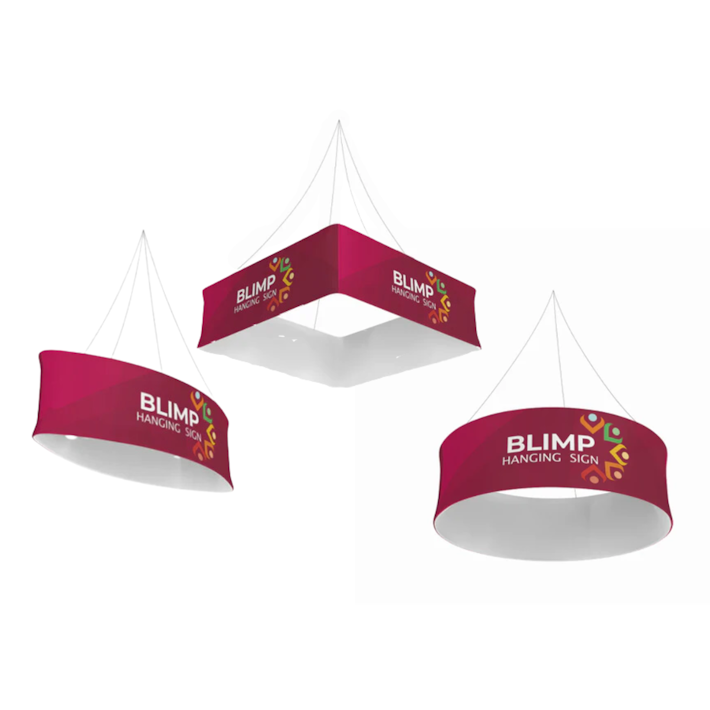
EXHIBITION HANGING STRUCTURES
Pop up display stands are one of the most common exhibition displays, but many people don’t know they can also be linked together to form L-shaped, curved or U-shaped backwalls. Despite the expandable frame being able to fit inside a small carry case, pop up stands can still accomodate small LEDs, literature stands and shelves although the load-bearing capacity is not that high. For a more versatile load-bearing pop up a system, see the Vario D400 Pop up system.
Pop up stands are very easy to assemble without tools, the frame literally ‘pops up’ to form a large backwall on which you can attach your polypoprolene or fabric graphics using hooks and magnetic strips. Pop ups are not as versatile as some of the other systems as the individual frames cannot be attached, instead the print media bridges the gap between the individual frames.
Advantages
The easiest modular stand to assemble, no tools required
Easy to use one frame for smaller shows and add additional frames for bigger displays
One of the most cost-effective mid-scale exhibition displays
Disadvantages
Not completely modular – restricted to shape of individual frames
Light frames can’t hold very heavy accessories such as larger TVs
Doesn't have the height of other modular stands

TWIST BANNER SYSTEM
The Twist banner system is one of the most popular modular displays that is available. A single Twist banner stand looks the same as a conventional banner stand, however the key difference is that these printed displays can be linked together to form larger backwall-like displays.
The configurations with a Twist system are endless: from a straight or curved backwall to a multi-tiered or circular shape. The Twist systems also accommodate LCD screens and are a light, portable option for any exhibitor on-the-go.
Advantages
Easily ‘twists’ for configurable display
Interlinked individual banner system so banners can be added or removed for different message
Light and easily transported
Disadvantages
Too light to accommodate heavy accessories
Graphics can be damgaged if treated incorrectly
Doesn't have the height of some modular stands
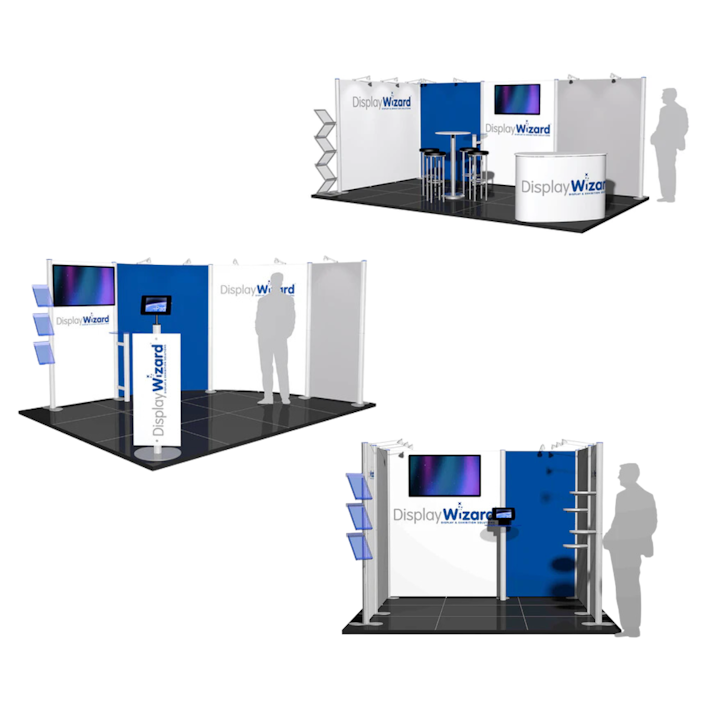
CENTRO MODULAR DISPLAYS
Centro modular displays are one of the most modular displays available, with a large range of accessories and extras available.
Made up of a linkable aluminium frame with clip-in graphics, Centro displays are a high-end display solution that will be able to attract premium customers.
There is no limit to the configurations avaialable with TVs, iPads, doors and literature holders all easily intergrated into the display stand.
Advantages
Extremely modular display
Lightweight aluminium frame makes it easy to transport
Simple 'twist and lock' tool-free assembly.
Disadvantages
Relatively high cost.
Takes longer to assemble than some other modular displays.
Components can be bulky to transport.

GANTRY EXHIBITION SYSTEM
GANTRY EXHIBITION SYSTEM
Gantry modular stands are an aluminium truss system that displays fabric graphics inside its latticed, visually appealing frame. This is the most durable and weight-bearing modular display system out there – best suited for displaying heavy items of machinery or vehicles if required.
The heavy-duty gantry frame means you can easily hang plasma screens, projectors or large lighting systems from the stand.
Advantages
Strong and durable for displaying heavier accessories or products
Large-scale exhibition system
Hard-wearing for multiple events
Disadvantages
'Industrial’ style may not suit all business types
Frame will take up more space in transit than other more portable systems
Tricky to assemble, tools require
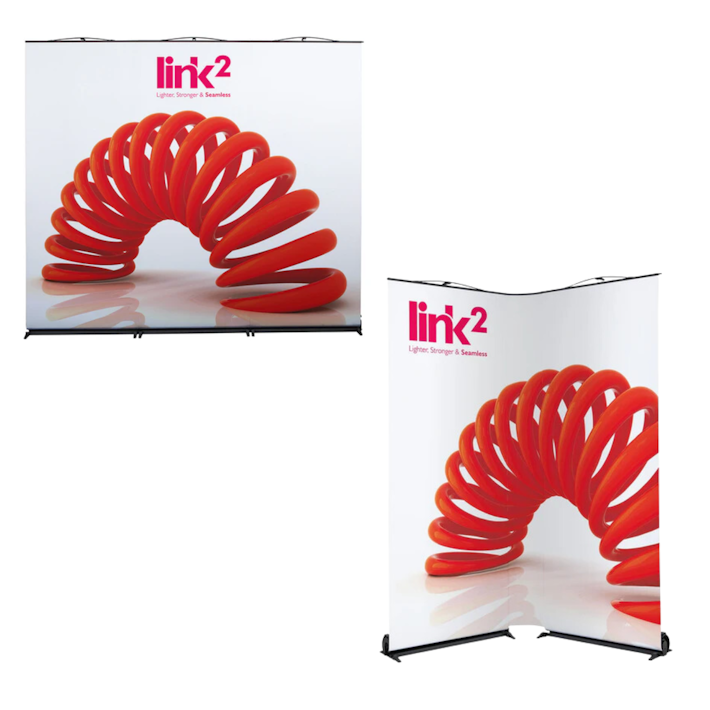
LINK2 BANNER SYSTEM
The LINK2 banner system is the world's first seamlessly linking roller banner system.
Combining the simplicity of a roller banner with the adaptibility of the Twist display, the Link2 is a verstaile display solution ideal for exhibitors attending a number of different shows throughout the year.
The stand can be used as a conventional single banner stand or joined together for a larger, more bespoke display.
Advantages
Very simple to assemble, just pull up from the base and attach to another stand.
Can be used as a single roller banner or a larger modular display depending on your requirements.
Graphic can be easily replaced without the need to buy a new base unit.
Disadvantages
No TV can be integrated unlike the Twist system.
Not as modular as the Twist when it comes to varying heights.
May not give the 'wow' factor of other modular displays
Types of modular exhibition system
Designing your modular exhibition system
Designing a modular display system is a crucial aspect of your stands' success, as you need to take into account the different configurations you may need for different events.
Many exhibitors who have modular stands for various shows have one ‘key’ panel or frame which displays their logo and contact information with a number of supplementary panels/frames which can be added to suit different sizes of stand spaces.
Because of these considerations it is best to work closely with your supplier for the best design, although if you read about how to design an exhibition stand along with the product spec. you may be able to come up with your own design.
Looking after your modular exhibition system
To ensure modular exhibition stands become a good investment you’ll need to ensure you get to re-use your system time and time again. The hardware on the systems are generally very durable and also carry 5, 10 or even lifetime guarantees.
Therefore the wear and tear on a modular stand usually comes on the graphics. We recommend our guide on how to extend the life of an exhibition stand for a few tips on best practices.
Which supplier should I choose for my modular stand?
Display Wizard are one of the UK’s leading suppliers of modular stands for businesses and organisations around the country, in Europe and further afield.
Talented, In-house Design Team
We can help you create the best possible pop up stand & bring your vision to life.
Top-quality print facilities
This mean your graphics will stand the test of time and maintain quality.
Super fast UK mainland delivery
Order any modular stand or counter and get super-fast UK mainland delivery!


